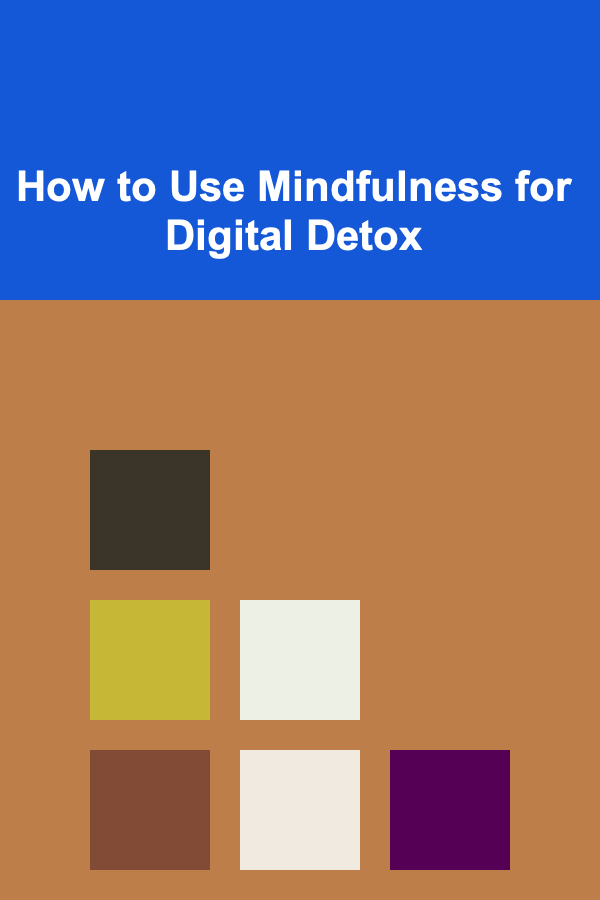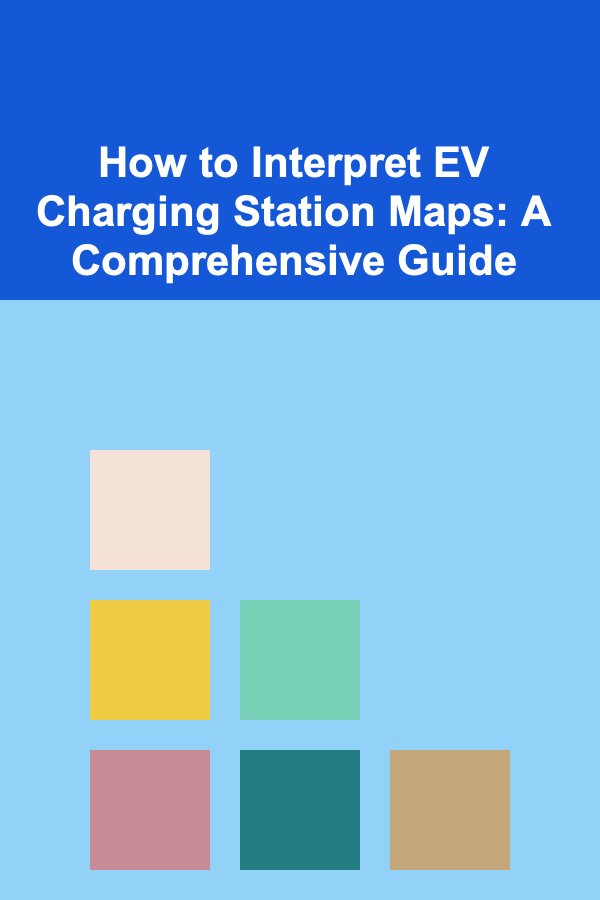
How to Use Mindfulness for Digital Detox
ebook include PDF & Audio bundle (Micro Guide)
$12.99$11.99
Limited Time Offer! Order within the next:

In today's fast-paced world, technology has become an inseparable part of our daily lives. Smartphones, computers, social media, and various digital platforms dominate our time and attention, often leading to mental fatigue, stress, and anxiety. While technology offers countless conveniences, it also has its downsides, especially when used excessively.
One of the most effective ways to combat the negative effects of excessive digital consumption is through a practice known as mindfulness . Mindfulness is the act of being present in the moment, paying full attention to the here and now without judgment or distraction. When used strategically, mindfulness can act as a powerful tool for a digital detox, helping individuals regain control over their time and mental well-being.
In this article, we will explore the connection between mindfulness and digital detox, examining how mindfulness practices can help reduce screen time, manage digital overload, and ultimately foster a healthier relationship with technology.
The Impact of Technology on Mental Health
Before diving into how mindfulness can assist with a digital detox, it's important to understand the impact of technology on mental health. Technology, while beneficial, has been linked to several negative psychological outcomes, such as:
1. Increased Stress and Anxiety
Constant notifications, emails, and updates on social media platforms can create a sense of urgency, making individuals feel like they need to be available and responsive at all times. This "always-on" mentality can result in elevated stress levels, as people are often bombarded with information without the opportunity to process or decompress.
2. Disrupted Sleep Patterns
The blue light emitted by screens, particularly in the evening, can interfere with the production of melatonin, the hormone that regulates sleep. The constant engagement with digital devices before bed, such as watching videos, checking social media, or responding to work emails, can lead to poor sleep quality and insomnia.
3. Reduced Attention Span
The fast-paced nature of digital content consumption---scrolling through social media feeds, binge-watching shows, and multitasking on different apps---has been shown to shorten attention spans. This constant shift between tasks prevents individuals from focusing deeply on any one activity for an extended period, which can be detrimental to both productivity and personal well-being.
4. Decreased Mindfulness and Presence
The more time people spend on digital platforms, the less present they are in their physical environment. The habit of mindlessly scrolling through content on a phone or computer can lead to a lack of attention to real-life experiences, diminishing one's ability to engage fully with their surroundings and relationships.
5. Social Comparison and FOMO (Fear of Missing Out)
Social media platforms can be a breeding ground for comparison, where individuals often measure their lives against the curated, idealized versions presented by others. This can lead to feelings of inadequacy, isolation, and the fear of missing out (FOMO), contributing to mental distress.
Given these negative impacts, a digital detox becomes essential for improving mental health, but the question is: how can mindfulness be used to facilitate this detox?
What is Mindfulness?
Mindfulness is the practice of being fully aware and present in the current moment, without judgment or distraction. It involves focusing on your thoughts, feelings, bodily sensations, and the surrounding environment, all while cultivating an attitude of acceptance and openness. In essence, mindfulness helps individuals cultivate a sense of awareness that allows them to experience each moment more vividly.
Key Principles of Mindfulness
- Awareness: The ability to notice and observe your thoughts, emotions, and sensations in real-time.
- Acceptance: A non-judgmental attitude toward whatever arises in your awareness, without trying to change or suppress it.
- Present Moment: Focusing your attention on the here and now, rather than dwelling on the past or worrying about the future.
- Non-Reactivity: Responding to thoughts and feelings with calm and composure, rather than reacting impulsively or emotionally.
How Mindfulness Can Aid in Digital Detox
When applied to a digital detox, mindfulness can help individuals regain control over their technology use, reduce the compulsive need to check devices, and foster healthier, more intentional habits. Here are some ways mindfulness can be used in conjunction with a digital detox:
1. Cultivating Awareness of Digital Consumption
The first step in any successful digital detox is becoming aware of how much time you spend on digital devices. Mindfulness helps individuals observe their digital habits without judgment. By paying attention to the triggers that lead you to reach for your phone or computer, you can identify patterns and develop more conscious habits.
- Mindful Monitoring: Use mindfulness techniques to observe when and why you use digital devices. For example, when checking social media or emails, notice how your body feels---are you tense or relaxed? Are you scrolling because you're genuinely interested, or is it out of habit or boredom?
- Tracking Time: Track the amount of time you spend on your devices. Use mindfulness to acknowledge the impact this time has on your mental and emotional state. Are you using technology in a way that aligns with your values, or are you simply reacting to external triggers?
By being mindful of your digital consumption, you can develop a clearer sense of whether your tech use is purposeful or simply a default response to boredom or stress.
2. Setting Intentional Boundaries with Technology
Mindfulness emphasizes the importance of setting intentional boundaries in all areas of life. In the context of a digital detox, setting clear limits on how, when, and where you use technology can help reduce its impact on your well-being.
- Digital Sabbath: Commit to designated times when you do not use any digital devices. This could be a full day (often referred to as a "digital sabbath") or smaller chunks of time throughout the day, such as an hour before bed or during meals.
- Mindful Phone Use: When you do use your phone or computer, set an intention before picking it up. For example, you might decide that you're using your device to check important emails and not to scroll mindlessly through social media.
- Notifications Off: One of the simplest ways to reduce digital overwhelm is to turn off non-essential notifications. By practicing mindfulness, you can cultivate an awareness of when notifications are becoming a source of stress and take steps to eliminate them.
3. Developing a Non-Reactive Relationship with Technology
One of the key aspects of mindfulness is non-reactivity---responding to thoughts, feelings, and external stimuli with composure, rather than reacting impulsively. When applied to digital detox, this principle helps individuals break the cycle of compulsively checking their phones or responding to notifications out of habit or anxiety.
- Pause Before Responding: The next time you receive a notification or message, practice a mindful pause before reacting. Ask yourself if the message requires an immediate response, or if it can wait. This helps break the automatic response cycle.
- Mindful Breathing: If you feel overwhelmed or anxious about a message, email, or social media post, use deep breathing techniques to ground yourself in the present moment. Mindful breathing can help calm the nervous system and prevent rash actions.
This non-reactive approach enables you to use technology with more awareness and control, rather than being at the mercy of digital distractions.
4. Creating Mindful Tech-Free Zones
Incorporating mindfulness into your digital detox can also involve designating specific spaces where technology is not allowed. This allows you to create physical environments that promote mindfulness, relaxation, and connection to the present moment.
- Tech-Free Zones: Identify areas in your home where you want to avoid digital devices, such as the bedroom, dining room, or bathroom. By creating these zones, you are reinforcing your commitment to disconnect from digital distractions and engage more fully with your environment.
- Mindful Activities: In tech-free zones, engage in activities that promote mindfulness, such as reading, journaling, cooking, or practicing yoga. These activities allow you to reconnect with yourself and your surroundings in a more meaningful way.
By establishing mindful tech-free zones, you create sacred spaces where you can escape the constant noise of digital life and focus on activities that bring you joy and fulfillment.
5. Engaging in Mindful Digital Detox Practices
There are several specific mindfulness practices that can support a digital detox, helping individuals reduce their screen time and re-establish healthy relationships with technology:
- Mindful Walking: Take a walk outside without your phone. Focus on the sensations of walking---the feeling of your feet on the ground, the sounds around you, and the sights you encounter. This simple practice can help break the cycle of digital overuse and foster a deeper connection with the world around you.
- Mindful Eating: Practice mindful eating by focusing entirely on the experience of eating---taste, texture, smell, and sensation. Avoid distractions like your phone or TV during meals, and savor the food you're consuming.
- Body Scan Meditation: A body scan is a mindfulness practice that involves paying attention to each part of your body, observing sensations without judgment. This practice can help calm the mind and reduce the urge to reach for a device during moments of boredom or stress.
These mindful practices not only help reduce screen time but also improve overall mental well-being, making it easier to maintain a sustainable digital detox.
6. Mindfulness to Reconnect with Yourself and Others
One of the primary benefits of a digital detox is the opportunity to reconnect with yourself and others. Mindfulness helps cultivate a sense of presence, which is essential for fostering deep connections with those around you.
- Mindful Conversations: When engaging with others, be present in the conversation. Put away your phone, make eye contact, and actively listen to what the other person is saying. This will strengthen your relationships and create a sense of shared connection.
- Self-Compassion: Be kind to yourself during your digital detox. Mindfulness encourages self-compassion, which means accepting your digital habits without judgment and gently guiding yourself toward healthier practices.
Through mindfulness, you can rebuild your capacity for genuine presence, both with yourself and the people you care about.
Conclusion
A digital detox, when combined with mindfulness, can lead to profound benefits for both mental and physical well-being. By developing awareness of your digital habits, setting intentional boundaries, practicing non-reactivity, and engaging in mindful activities, you can regain control over your technology use and foster a healthier relationship with the digital world.
In a society where digital distractions are increasingly prevalent, mindfulness offers a pathway to balance. It allows individuals to create moments of stillness, presence, and clarity, helping them reconnect with what truly matters---both online and offline. Through regular mindfulness practices, a digital detox becomes not just a temporary retreat but a sustainable way to live more fully and intentionally in the modern age.
Reading More From Our Other Websites
- [Personal Investment 101] How to Monetize Your Deep Learning Skills as a Freelancer
- [Home Soundproofing 101] How to Soundproof a Child's Room for Quieter Play
- [Weaving Tip 101] Best Natural Fiber Weaving: A Guide to Wool, Linen, Silk, and Beyond
- [Ziplining Tip 101] From Dawn to Dusk: Experiencing the Magic of a Lakeside Zipline
- [Organization Tip 101] How to Tackle Digital Clutter on Your Devices
- [Sewing Tip 101] Sewing Jargon Explained: From 'Notions' to 'Selvedge'
- [Personal Care Tips 101] How to Create Bold, Defined Eyebrows Using Brow Gel and Pencil
- [Home Space Saving 101] How to Maximize Space in Tiny Bathrooms with Storage Hacks
- [Scrapbooking Tip 101] Affordable DIY Embellishments: Crafting Your Own Scrapbooking Accents
- [Home Budget 101] How to Budget for Home Repairs and Unexpected Expenses

Crafting Effective Messaging: A Guide for Corporate Communicators
Read More
How to Arrange Vintage Finds in a Cohesive Style
Read More
How to Make Your Home Holiday-Friendly for Pets and Kids
Read More
Saving Big on Pet Care: Budget-Friendly Alternatives for Pet Care Services You Can Trust
Read More
How to Interpret EV Charging Station Maps: A Comprehensive Guide
Read More
How to Integrate Mindfulness into Your Yoga Planner
Read MoreOther Products

Crafting Effective Messaging: A Guide for Corporate Communicators
Read More
How to Arrange Vintage Finds in a Cohesive Style
Read More
How to Make Your Home Holiday-Friendly for Pets and Kids
Read More
Saving Big on Pet Care: Budget-Friendly Alternatives for Pet Care Services You Can Trust
Read More
How to Interpret EV Charging Station Maps: A Comprehensive Guide
Read More